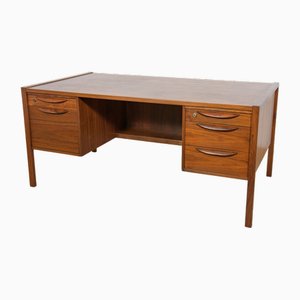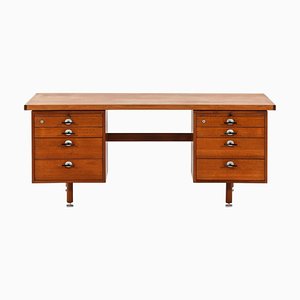
Danish-American architect-designer Jens Risom was born in Copenhagen in 1916, the son of a nationally renowned architect of the Nordic Classicism style. Between 1935 and 1938, he trained at the Royal Danish Academy of Fine Arts under Ole Wanscher and Kaare Klint, alongside classmates Hans Wegner and Børge Mogensen. For a short time following his studies, he took on furniture and interior designer projects for the Copenhagen-based architectural firm Ernst Kuhn. He then moved briefly to Stockholm, where he worked for Nordiska Kompaniet and met Alvar Aalto and Bruno Mathsson. Around 1939, he immigrated to New York with ambitions to introduce the Scandinavian modernist approach to the US furniture market.
Risom’s arrival in the US coincided with the years of materials shortages brought on by the war. As a result, Risom was unable to secure a position in a furniture company, and, instead, found work designing textiles for decorator Dan Cooper. Eager to do more, he soon convinced Cooper to expand into the furniture market, and together they found projects with young, progressive architects like Ed Stone and George Nelson. In 1939-40, Ed Stone was invited to create Collier Magazine’s House of Ideas pavilion at Rockefeller Center as part of the New York World’s Fair, and Risom designed all of the furniture.
Around 1941, Risom met Hans Knoll, a German-born entrepreneur in the furniture industry who had a showroom on Madison Avenue dedicated to rather lackluster furnishings. Sharing a dream to do something more vanguard, they joined forces and set off on a four-month tour of the US in search of design inspiration. By 1942, Knoll launched Hans Knoll Furniture Company with Risom on board as his head designer.
Risom’s early designs for Knoll made use of military surplus materials, including webbing and parachute cloth stretched over soft woods. As cherry wood became available again, Knoll released the company’s first catalogue, featuring 15 Risom designs, including cabinets, chests of drawers, bookcases, tables, and chairs. But as rationing amped up, Knoll asked Risom to revisit his more spartan designs. In 1943, they introduced the 650 Line, of which Risom’s Side Chair and Lounge Chair have become icons of 20th-century design. Later that year, Risom was drafted into the US Army.
When Risom returned from the war in late 1945, the atmosphere at Knoll’s company had shifted, due in large part to the increasing influence of Knoll’s soon-to-be-wife, Florence Schust. It seems that the tastes of Risom and Schust were incompatible, as he favored the softer, homier aesthetics of his Scandinavian roots mixed with vernacular Americana, while she was mentored by Ludwig Mies van der Rohe and was commited to pushing the minimalist, Bauhaus look. In 1946, Risom officially parted ways with Knoll and launched his own New York-based firm Jens Risom Design (JRD).
For 25 years—during the heyday of postwar modernism—Risom’s company built an international reputation for solid wood furniture in the Scandinavian style. His advertising campaigns, photographed by Richard Avedon, were widely acclaimed. Risom was included in the legendary 1961 Playboy Magazine article “Designs for Living,” alongside Charles Eames, Harry Bertoia, Eero Saarinen, Edward Wormley, and George Nelson. One of Risom’s executive office chairs was famously selected by President Lyndon Johnson for the Oval Office.
Risom sold JRD to Dictaphone in 1970, but stayed on as CEO for three years. He then moved to New Caanan and launched a consulting service called Design Control. In 1996, Risom was knighted in Denmark by Queen Margrethe II, and, in 1997, Knoll reissued his designs from the 1940s and ’50s—which are still in production today. In 2005, Risom began a long collaboration with furniture dealer Ralph Pucci.
Risom died in his New Caanan home in late 2016 at the age of 100.


